EU-Turkish Customs Union: How To Proceed – Analysis
By VoxEU.org
New EU trade agreements could adversely affect Turkey as a non-EU member. This column presents new findings of an economic analysis in which different trade policy scenarios are considered. The results point to a clear policy recommendation – Turkey and the EU should mutually deepen their customs union by including the agriculture and service sectors as soon as possible.
By Gabriel Felbermayr, Rahel Aichele and Erdal Yalcin*
In May 2015 the Turkish government, together with representatives of the EU, issued a Memorandum of Understanding with the objective of modernising and expanding the existing customs union between the two parties. This objective to expand economic policy relations between the EU and Turkey separately from the stagnating acquis communautaire may at first glance seem surprising, but it represents a possible step toward preventing the impending breakdown in economic and trade relations between the two regions.
While political negotiations on Turkey’s accession to the EU have not made much progress in recent years, bilateral economic relations are developing in a positive way despite the fact that Turkish membership of the customs union is initially restricted to industrial goods and processed agricultural goods. The starting point for this positive economic development was the Association Agreement between Turkey and the former European Economic Community, the so-called Ankara Agreement. Initiated in 1963, it resulted in the signing of the present customs union in 1995, which came into effect a year later in 1996. Turkish industry has therefore been increasingly linked to the European economy since then. Figures 1 and 2 illustrate the strong growth both in exports and in imports in Turkey since 1996. In particular, German companies use the customs union with Turkey to produce intermediate goods cost-effectively in the country and then re-import them for further processing in Germany. It is therefore unsurprising that the majority of foreign direct investment in Turkey comes from German companies.
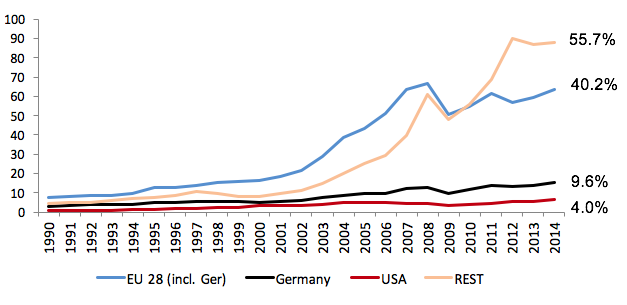
Source: OECD STAN and author’s own illustration
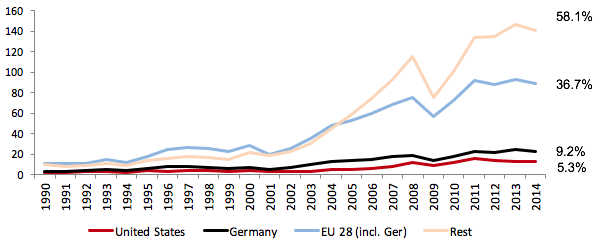
Source: OECD STAN and author’s own illustration
Moreover, Figure 3 presents the composition of annual Turkish exports to the EU by making a distinction between high, mid-high, mid-low, and low technology goods. It becomes very clear that the introduction of the customs union has led to a significant rise in exports to the EU which is categorised as mid-high and mid-low technologies.
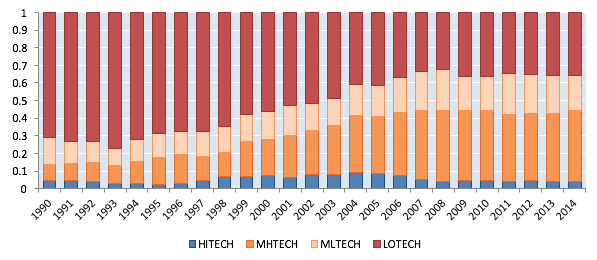
Source: OECD STAN and author’s own illustration
The integration of Turkish industry into the EU economy becomes even clearer when trade in finished and intermediate goods is examined more closely at a sectoral level. Figure 4 demonstrates that, in the Turkish metals sector, for example, approximately 85% of exported metal goods to the EU are intermediate goods. A similar bilateral trade pattern can be found in the chemical industry. Strong European-Turkish trade in intermediate goods can also be found, to a lesser extent, in the automobile sector.
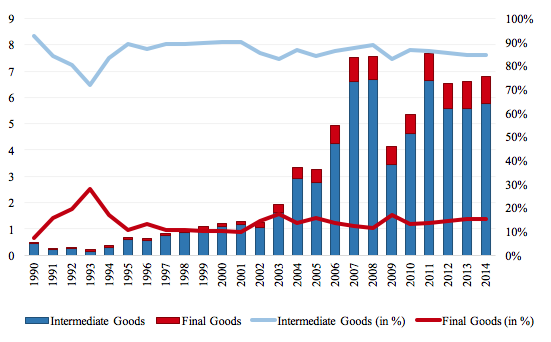
Source: OECD STAN and author’s own illustration
These descriptive statistics illustrate clearly that Turkey is increasingly used by European companies as a production location for intermediate goods where components are improved and subsequently re-imported into the EU. With the customs union Turkey has become increasingly an important part of European production chains.
The success of this economic integration has, however, been under threat for some time, since institutional weaknesses in the organisation of the European customs union for Turkey have brought about prospective negative consequences for the Turkish industry. The European Commission’s focus on signing new regional trade agreements, such as with the US (the Transatlantic Trade and Investment Partnership), Japan and Canada for example, has highlighted institutional weak points in what was previously a successful customs union between Turkey and the EU.
As a result of the customs union agreed with the EU, and the corresponding principle of joint customs harmonisation for third countries, Turkey is obliged to open up its market to these third countries when the EU signs free trade agreements with them. In return, Turkish companies can establish free commodity trade with the EU28 states, but cannot claim any of the benefits that are negotiated for European exporters to third countries. Technically there is discrimination against Turkish exports in free trade agreements with third countries, since EU trade agreements are negotiated at the EU level and non-members have no right to participate in agreements.1
Our analysis clearly illustrates that without a modernised EU-Turkey trade agreement, Turkey faces the threat of significant foreign trade losses (Felbermayr et al. 2016). The estimated potential welfare loss in the medium term, totalling around 0.01% of Turkish GDP, appears to be relatively small, but certain Turkish export sectors can expect substantial losses. The automotive and mechanical engineering sectors could experience declines in trade volume of 10% and 4%, respectively. If further long-term adjustments of the EU’s free trade agreement with third countries are accounted for, welfare losses equivalent to over 1.5% of Turkish GDP are possible.2
Policy options: Deepening versus rollback of the customs union
One theoretical option to balance trade in an increasingly regionalised world is to dissolve the mutual customs union between Turkey and the EU. However, that would be a step backward for Ankara’s economy, as our analysis shows. The imbalance resulting from asymmetric customs duties in trade relations would be eliminated, but without a customs union, the Turkish economy would face an end to its privileged access to the European market, which, in turn, would have serious effects. Termination of the current EU-Turkish customs union would lead to a decline in Turkish GDP of 0.81%. The effects of a new EU trade agreement would then cause Turkish GDP to fall by another 0.96%. And the EU could also expect some losses in such a scenario too.
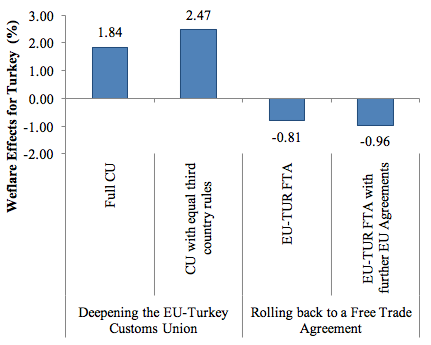
Note: A full CU refers to a situation in which the EU and Turkey include the agricultural and service sectors into the existing customs union agreement. Equal third country rules consider a situation in which Turkey receives an equivalent trade access to third countries as EU exporter. EU-TUR FTA considers a scenario in which the EU and Turkey transform the existing customs union into a bilateral free trade agreement covering all sectors. The last scenario assumes additionally FTAs between the EU and further six regions (TTIP, CETA, Japan, India, MERCOSUR, ASEAN).
A viable solution resulting from our analysis is to enhance the existing agreement. Its expansion to include agriculture and services may not only offset the negative effects of the asymmetry for Turkey, but may also result in gains for both sides. Expansion of the customs union could lead to a 1.84% increase in Turkish GDP. Agricultural exports to the EU are forecast to rise by 95% and exports of services by as much as 430% over the next decade.
Should the new trade agreements of the EU – such as TTIP or CETA – be signed, the income level in Turkey would continue to increase thanks to higher demand for services in the EU. Expansion of the customs union plus signing the currently planned agreement could generate a 1.95% increase in Turkish GDP. Per capita income would rise by nearly $200. If Ankara signs its own trade agreements with new partners in the EU, GDP could rise by an additional 2.5%, which would correspond to a nominal increase of $18 billion.
Including the Turkish agricultural and services sectors into the European customs union also offers economic opportunities for EU countries. This would give the Turkish government a policy space for correcting its asymmetric trade agreement with the EU. More precisely, the agreement should be formally expanded in relation to the free trade agreement between the EU and non-member countries so that any future easing of duties for European companies in third countries could also be considered for Turkish companies.
*About the authors:
Gabriel Felbermayr, Director, Ifo Center for International Economics, Ifo Institute for Economic Research in Munich
Rahel Aichele, Economist, Ifo Center for International Economics, Munich
Erdal Yalcin, Deputy Director, Ifo Center for International Economics, Munich
References:
Caliendo, L. and F. Parro (2015). “Estimates of the Trade and Welfare Effects of NAFTA”, Review of Economic Studies, 82(1): 1-44.
Egger, P., Francois, J., Manchin, M., Nelson, D. (2015): “Non-tariff barriers, integration and the transatlantic economy“, Economic Policy 83, pages 539-584.
Felbermayr, G., Aichele, R., and Erdal Yalcin (2016). “Turkey’s EU integration at a crossroads,” Bertelsmann-Foundation, Gütersloh.
Endnotes:
[1] In addition to Turkey, Andorra and the Republic of San Marino have the same asymmetrical treaty obligations and rights in free trade agreements between the EU and third countries.
[2] Egger et al. (2015) also report negative cumulative welfare effects for Turkey from the Transatlantic Trade and Investment Partnership.

